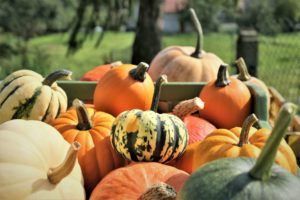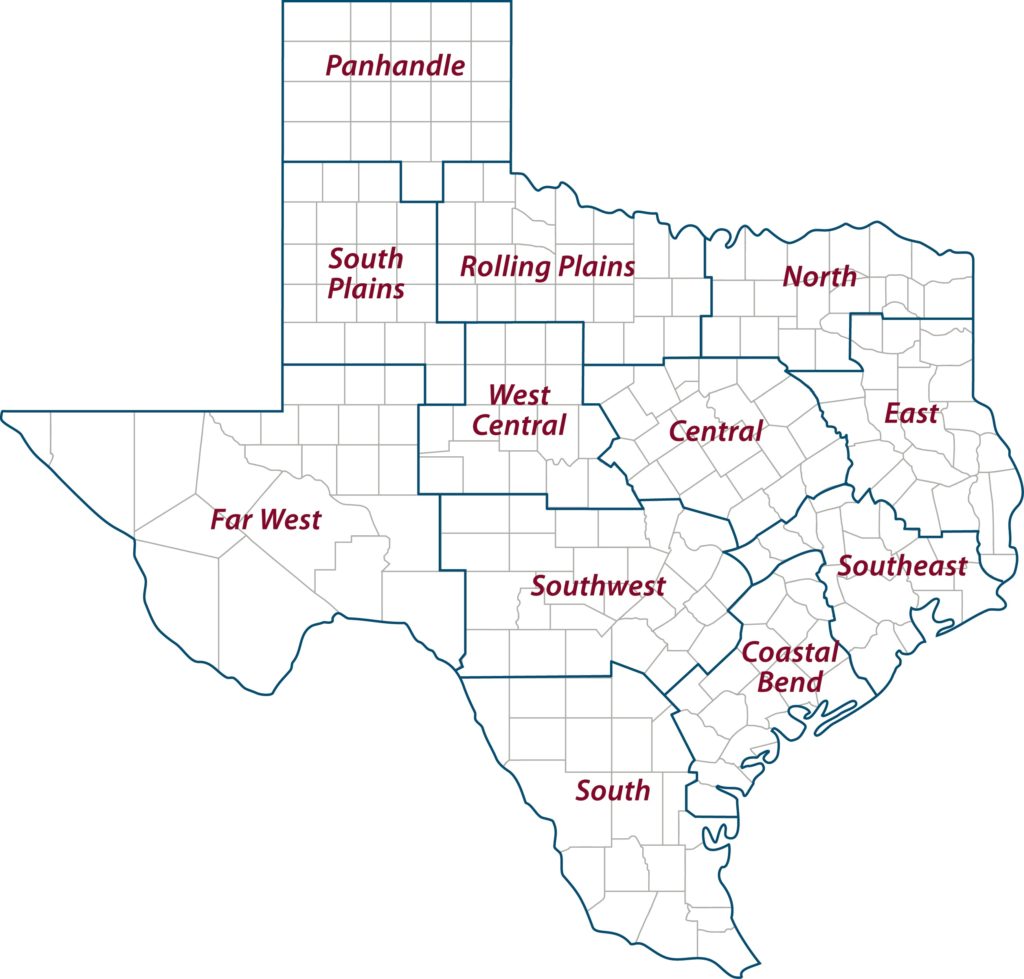Texas pumpkin yields down, quality up
Texas Crop and Weather Report – Oct. 6, 2020
Floydada pumpkin harvest nears completion in a season with below-average yields and above-average quality, according to a Texas A&M AgriLife Extension Service expert.
Mark Carroll, AgriLife Extension agent, Floyd County, said producers were reporting yields were down 20%-30% compared to last year, but higher quality due to low disease pressure.

Carroll said very little rain and low humidity led to very few heavy dews during the season, which can allow funguses to establish and proliferate.
“It was so dry, and pumpkins require a lot of water, but they’re also very susceptible to funguses,” he said. “So, the dryness hurt and helped. The quality is some of the best it’s ever been because of the low disease pressure.”
Pumpkins in demand
There are a few pumpkin acres outside of the 600 production acres in Floyd County, Carroll said, but Floydada has established itself as the “pumpkin capital” of Texas.
Most producers were finishing harvest this week just in time for Punkin’ Days, the annual pumpkin festival, he said. Floydada pumpkins are marketed throughout the state and the U.S.
“It used to all be pumpkins for jack-o-lanterns, but some have gotten into specialty varieties, gourds and odd pumpkin types. The growers have come up with some innovative ways to market their pumpkins, and they work together in ways that are good for everybody.”
Tanner Smith, a Floydada pumpkin grower, said tonnage was lower than expected in some areas, but that quality and demand were “through the roof.”
Smith said operations there typically begin taking wholesale orders August-September and focus on direct-to-public retail sales in October. Producers are turning away nonstop calls for wholesale orders, so prices are expected to be higher than normal.
“There were a lot of acres lost to freeze in New Mexico, so that affected supplies,” he said. “Demand has been way up. Everybody in Floydada is sold out as far as the wholesale market goes. I think some are wishing they’d hung on to more pumpkins for the retail market.”
AgriLife Extension district reporters compiled the following summaries:

CENTRAL
Weather conditions were dry with slightly above-normal temperatures. Conditions allowed for excellent progress preparing land for fall plantings. The first fields of winter forages and wheat were planted but had not yet emerged. Dry weather was in the forecast, and producers expect fieldwork and fall plantings to continue unimpeded. Livestock were in excellent condition with plenty of new forage to graze. A few acres of corn remained unharvested. Cotton harvest was nearing completion. Producers applied dry fertilizer to row crop fields. Ryegrass was emerging. Hay producers were cutting hay rather than spraying for armyworms. Quite a bit of hay was being baled due to September rains. Half the district’s counties reported adequate soil moisture. Overall, most areas reported fair rangeland, pasture and crop conditions.
ROLLING PLAINS
The district experienced another week with favorable temperatures. Cotton field conditions varied from fair to good as many fields reached the open-boll stage. Area wheat producers continued planting fields while some early planted wheat started to emerge. Pasture and rangelands continued to be in fair to good condition. Cattle were in good condition with plenty of grass to graze.
COASTAL BEND
Conditions were cool and dry. The pleasant fall weather allowed topsoil to dry following a week of moisture from Tropical Storm Beta. Winter pasture planting continued. Hay fields were improving after recent rains. Some late-season hay was being harvested. Armyworm moths were seen, and producers were on the lookout for armyworms. Pecan harvest of early varieties should begin soon. Cattle were in good condition with steady to higher prices.
SOUTH PLAINS
Dry conditions continued across the district. Farmers were busy spraying defoliant on cotton and should start stripping soon. A few farmers started stripping last week, and the gins had started ginning cotton fiber. Pumpkin harvest was in full swing. Farmers were busy planting winter wheat. Irrigated wheat was starting to emerge in a few areas. Pastures were in poor condition due to the lack of rainfall. Cattle were in good condition.
PANHANDLE
Weather was dry and warm. Topsoil and subsoil moisture levels were adequate to very short. Pasture and rangeland were in fair to good condition. Corn, cotton and sorghum conditions were poor to good. Sorghum harvest was underway.
NORTH
Soil moisture levels were mostly adequate across the district. Cooler weather continued with trace amounts of rain reported. Temperatures dropped into the 50s most nights and ranged in the mid-70s to mid-80s during the day. Cooler temperatures contributed to slow grass growth. Producers were planting winter pastures and cutting and baling hay. Cotton and soybeans were being harvested. Some counties reported severe armyworm infestations. Cattle were going into the winter in good shape.
FAR WEST
Temperature ranged from highs above 100 degrees in the daytime to nighttime lows in the mid-40s. No precipitation was reported. Daylight hours were reducing. Cotton bolls were still opening, and some cotton may have some good yields, possibly 3 bales per acre. Quite a few fields were sprayed with defoliant, and harvest should pick up considerably over the next two weeks. Wheat planting was at a standstill due to cotton harvest and low soil moisture. Armyworms were found, and numbers continued to increase in hay grazer and a few emerged wheat fields. Many folks were trying to decide between planting crops dry or waiting for rain. Peanuts were mature but not quite ready to be dug. Topsoil and subsoil were adequate. Rangelands and pastures were starting to green up from recent moisture and the temperature change. Pecans continued to fill out. Livestock were in good condition overall. Dove and deer hunters were active hunting, filling feeders and preparing deer camps around the district. Producers continued to provide supplemental feed to livestock and wildlife.
WEST CENTRAL
Morning temperatures were cool with mild temperatures in the afternoon. Pastures greened up, and winter grasses and forbs were emerging. Some irrigated cotton was being defoliated for harvest. Moisture conditions allowed producers to start wheat planting. Feeder cattle prices seemed to be improving on the expectations for wheat grazing, but fields needed rain to continue growth. Pecan harvest was underway, and the crop appeared to be a bit better than expected.
SOUTHEAST
Recent rains improved conditions in some areas, but dust was blowing again in other areas. Cool-season forages were being planted and late-season hay baling continued. Rangeland and pasture ratings were poor to excellent with good ratings being the most common. Soil moisture levels were adequate to surplus with adequate levels being the most common.
SOUTHWEST
Temperatures were cooler with mostly sunny skies and little moisture reported. Pasture and rangeland conditions were holding steady. Preparations for wheat and winter pasture plantings were underway. Cotton harvest was winding up on the later planted cotton. Cattle, sheep and goat markets were doing well. Fall shearing continued. Livestock and wildlife were in fair to good condition. Bexar County reported supplemental feeding had slowed.
SOUTH
Counties around the district reported mild weather conditions with adequate to short soil moisture levels. Some areas reported cooler mornings, but temperatures reached into the low- to mid-80s daily in most areas. Cotton harvest was wrapping up and the peanut harvest was kicking off, though many fields were still maturing. Farmers were busy plowing under warm-season crop remnants and preparing for fall crop plantings. Watermelon and cantaloupe harvests were almost complete, and the farmers were preparing the soil for next season. Citrus fruit will continue its maturation process with the harvest beginning in the next few months. Pecan orchards were almost ready to harvest, and trees looked healthy with no pest pressure. Strawberry beds were being prepared, and planting should start soon. Winter vegetables were coming along nicely. Wheat planting continued. Pasture and rangeland conditions were fair to good. Forage producers were making their last cutting of the season. Producers continued to harvest buffelgrass seed. Cattle body conditions were fair to good as well. Ranchers were busy working and selling cattle and weaning calves. Webb County producers reported that tanks were stocked with water, and supplemental feeding continued despite decent forage availability. Some ranchers were preparing their fields for oats and winter rye. Cattle sales were up but prices were steady to slightly lower. Some producers were buying cattle to rebuild herds reduced due to drought. Deer and quail numbers seemed to be above average and thriving, but dove hunters and harvests were below normal.


